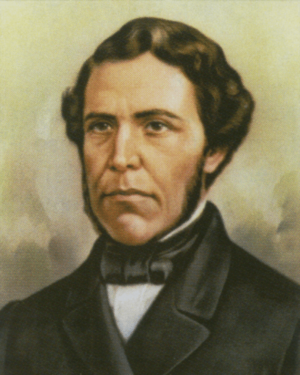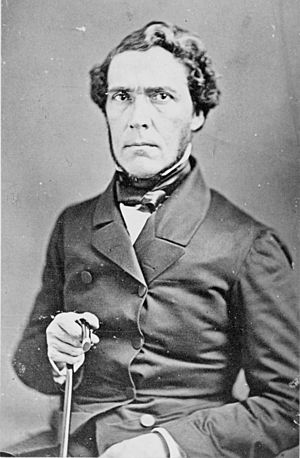Juan Bautista Ceballos facts for kids
Quick facts for kids
Juan Bautista Ceballos
|
|
|---|---|
 |
|
| 20th President of Mexico | |
| In office 6 January – 8 February 1853 |
|
| Preceded by | Mariano Arista |
| Succeeded by | Manuel María Lombardini |
| Personal details | |
| Born | 13 May 1811 Durango, Durango |
| Died | 20 August 1859 (aged 48) Paris, France |
| Nationality | Mexican |
| Political party | Liberal |
| Alma mater | College of San Nicolás |
Juan Bautista Ceballos (1811-1859) was a Mexican politician who became president for a short time in 1853. Before that, he worked in the Mexican congress and on the country's highest court. He became president after the previous leader, Mariano Arista, resigned during a revolution. Ceballos tried to make peace with the rebels, but he couldn't. He resigned after only about a month and went back to his job on the Supreme Court. Later, he left Mexico and passed away in Paris, France, in 1859.
Contents
Early Life and Career
Juan B. Ceballos was born in Durango, Mexico, in 1811. When he was very young, his family moved to Valladolid (now called Morelia). He studied law there and became a lawyer in 1835. During his studies, he became good friends with future important figures like Melchor Ocampo and Santos Degollado.
Ceballos later served in the Mexican congress during the Mexican American War. Because of his excellent work there, he was chosen by the states to be the president of the Supreme Court in 1852. While leading the court, he was known for saying that a presidential rule limiting newspapers was against the law.
In early 1853, President Mariano Arista lost support from most of the country due to a revolution. He decided to resign on January 5, 1853. That same night, Juan B. Ceballos was told that he was now the president of Mexico.
Presidency: A Short Term
Ceballos officially became president on January 6, 1853. He quickly formed his government, choosing new ministers to help him lead the country.
Seeking Peace and Compromise
Congress gave Ceballos special powers for three months. These powers came with conditions: he couldn't change the government's structure, existing agreements with other countries, or rules about the church or private property.
Since Ceballos became president to find a peaceful solution with the revolutionaries, he took several steps. He released political prisoners and offered forgiveness to people who had committed political offenses. He also asked state governors to help reduce fighting and find a peaceful agreement. Ceballos also reversed some changes that the previous president, Arista, had made to taxes on goods coming into Gulf Coast ports. He suggested recognizing the state leaders chosen by the rebels and bringing back officials that Arista had unfairly removed.
Challenges with Congress
Congress was not cooperating with Ceballos's plans. Many members weren't even attending meetings, which made it hard to get things done. Ceballos eventually decided to agree to the rebels' demands, hoping to still lead the movement.
On January 19, a plan was presented to congress. It called for a national meeting to create a new constitution and choose a president. Many members of congress were very upset because this plan would basically end their own power. They accused Ceballos and his ministers of being traitors. In response, Ceballos decided to close down congress.
Congress then tried to meet secretly to remove Ceballos from power and elect a new president. They chose the governor of Puebla, but he refused the job. Then, Marcelino Castaneda, a judge from the Supreme Court, was chosen and accepted. However, he was stopped by the Puebla government and couldn't take office. Ceballos, learning of these secret meetings, stopped them from happening. His ministers resigned, but one, General Blanco, stayed and tried to talk with a revolutionary leader.
Loss of Power and Resignation
Ceballos tried to get a loan and raise taxes, but lenders were worried because his government seemed about to fall. The only thing delaying his downfall was that the rebel leaders couldn't agree among themselves. Some wanted to keep the current system, others wanted to bring back an older plan, and some wanted to bring back former president Antonio López de Santa Anna.
A former minister, General Robles Pezuela, joined forces with other leaders and created a new plan on February 4, 1853. This new plan would allow a group of important people to choose a president with strong powers. This president would rule until a new constitution was written.
Ceballos saw that he was losing all his authority. He rejected this new plan, but he no longer had the power to stop it. His remaining minister, Blanco, sided with another general, Lombardini, who controlled the army in Mexico City. The new plan was changed to allow exiled citizens to be candidates for president, which clearly meant Santa Anna could be chosen.
Realizing he couldn't win, and not wanting to help Santa Anna return to power, Ceballos resigned on February 7, 1853. He went back to his old job on the Supreme Court. The rebels then chose Lombardini as the new president.
Later Life
After Santa Anna returned to power, Ceballos was removed from the Supreme Court and had to leave Mexico. When Santa Anna was overthrown by a liberal movement in 1855, some people wanted Ceballos to become president again. However, Ceballos did not want to return to public life and settled in France. He became very ill and was visited by other important Mexicans living in France at the time. He passed away in Paris on August 20, 1859.
See also
 In Spanish: Juan Bautista Ceballos para niños
In Spanish: Juan Bautista Ceballos para niños


